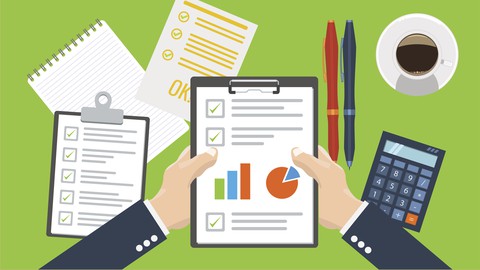
Cost Accounting: Introduction to Management Accounting
Cost Accounting: Introduction to Management Accounting, available at $84.99, has an average rating of 4.61, with 53 lectures, 22 quizzes, based on 1252 reviews, and has 7342 subscribers.
You will learn about Understand Cost Behaviors, Cost Drivers and Cost Driver Activity Define Fixed and Variable Costs and Create Cost Functions Use Regression Analysis using the Least Squares Method Apply Activity Based Costing to Product Costs Allocate Support Department Costs using the Direct, Step-Down and Reciprocal Method Apply Cost-Volume-Profit Analysis (Break-Even Points) Describe variance analysis, differentiate between price and usage variances, and calculate price and usage variances for costs Prepare Cash Budgets Prepare Production Reports for a Process Costing System This course is ideal for individuals who are University Students or College Students or CPA Students or MBA Students or Bookkeepers or Accountants or Managers It is particularly useful for University Students or College Students or CPA Students or MBA Students or Bookkeepers or Accountants or Managers.
Enroll now: Cost Accounting: Introduction to Management Accounting
Summary
Title: Cost Accounting: Introduction to Management Accounting
Price: $84.99
Average Rating: 4.61
Number of Lectures: 53
Number of Quizzes: 22
Number of Published Lectures: 52
Number of Published Quizzes: 16
Number of Curriculum Items: 75
Number of Published Curriculum Objects: 68
Original Price: $19.99
Quality Status: approved
Status: Live
What You Will Learn
- Understand Cost Behaviors, Cost Drivers and Cost Driver Activity
- Define Fixed and Variable Costs and Create Cost Functions
- Use Regression Analysis using the Least Squares Method
- Apply Activity Based Costing to Product Costs
- Allocate Support Department Costs using the Direct, Step-Down and Reciprocal Method
- Apply Cost-Volume-Profit Analysis (Break-Even Points)
- Describe variance analysis, differentiate between price and usage variances, and calculate price and usage variances for costs
- Prepare Cash Budgets
- Prepare Production Reports for a Process Costing System
Who Should Attend
- University Students
- College Students
- CPA Students
- MBA Students
- Bookkeepers
- Accountants
- Managers
Target Audiences
- University Students
- College Students
- CPA Students
- MBA Students
- Bookkeepers
- Accountants
- Managers
Welcome to the Management Accounting Crash Course, which will provide you with 46 video lessons that span over 7 hours of content (including quizzes to help test your knowledge). Follow along as I explain the basics and fundamental concepts like cost drivers, the cost function, break-even points, journal entries, joint costing, budgets and more!�
Managerial Accounting is the study of internal financial information that can influence decision-making. It’s the follow up course to Financial Accounting, that can prove to be more difficult for students. We designed the course to act as a perfect supplement for those taking Managerial/Management Accounting in University or College. We’ll walk you through the theory, providing examples and questions that will keep you engaged.
The first part of the course will cover:
-
Cost Measurement and Cost Behavior
-
The Design of Cost Functions
-
Fixed Costs, Variable Costs and Mixed Costs
-
Break-Even Analysis
-
Handling Direct and Indirect Costs
The second part will cover:
-
Process Costing, and Production Reports using Weighted Average and FIFO.
-
Activity-Based Costing for Overhead Costs
-
Preparing Cash Budgets
-
Variance Analysis
-
Support Departments: Direct, Step-Down and Reciprocal Method
-
And much more!
HERE’S WHAT SOME STUDENTS OF HAVE TOLD ME ABOUT MY COURSE:
“I fully attribute me passing the BEC portion of the CPA exam from your videos. Without your easy to learn managerial accounting tutorials, I would never have understood the concepts. I especially thought your videos on variance analysis were exceptional. Thank you so much for everything!” – Spencer S.
“Hi, I just wanted to say thank you for posting such great videos on YouTube. I believe that they were the reason I just passed my very difficult accounting exam! They were very easy to watch and easy to follow. I appreciate your work!” – Alana M.
“This guy has the best Mgmt Accounting tutorial videos. He understands the concepts and can explain them in the easiest and most engaging way. Thank you.” – Karen K.
“Great Course for being introduced to Fundamentals of Management Accounting. Dave does a good job at explaining concepts filled in with examples.” – Imran S.
Course Curriculum
Chapter 1: Managerial Accounting Introduction
Lecture 1: What is Managerial Accounting
Lecture 2: Managerial (Cost) Accounting Glossary
Chapter 2: Types of Costs, Cost Drivers and The Relevant Range
Lecture 1: Cost Drivers
Lecture 2: Fixed and Variable Costs
Lecture 3: Variable vs Fixed Costs
Lecture 4: The Relevant Range
Lecture 5: Mixed Costs
Chapter 3: The Cost Function Series
Lecture 1: The Cost Function
Lecture 2: Slope and The Cost Function
Lecture 3: The High-Low Activity Method
Lecture 4: Regression Analysis: Least Squares Regression Method
Lecture 5: Interpreting Regression Output for the Cost Function
Chapter 4: Break-Even Points (Cost-Volume Profit Analysis)
Lecture 1: Break-Even Points and Cost-Volume-Profit Analysis
Lecture 2: Solve Break Even Points Using Algebra
Lecture 3: The Contribution Margin and Break Even Points
Lecture 4: The Contribution Margin vs. The Gross Margin
Lecture 5: What is the Margin of Safety?
Lecture 6: Calculate the Break Even Point for a Sales Mix
Lecture 7: How Profit and Tax Affects Break-Even Points
Lecture 8: What is Financial Leverage or Leveraging
Lecture 9: Operating Leverage and Profit
Lecture 10: The Degree of Operating Leverage
Chapter 5: Job-Costing and Direct vs Indirect Costs
Lecture 1: Direct vs Indirect Costs: Example using Portal Guns!
Lecture 2: Manufacturing Costs and Product and Period Costs
Lecture 3: Raw Materials, Work in Process, and Finished Goods Inventory
Lecture 4: Prepare a Cost of Goods Manufactured Statement
Lecture 5: Journal Entries for Job-Order Costing
Lecture 6: Predetermined Overhead Rate and Overhead Applied
Lecture 7: Prorating and Writing Off Under/Over Applied Overhead
Chapter 6: Process Costing
Lecture 1: Job Order Costing vs Process Costing
Lecture 2: Overview of a Production Report for Process Costing
Lecture 3: Production Report for Weighted Average Method in Excel
Lecture 4: Production Report using the FIFO Method in Excel
Chapter 7: Activity-Based Costing Systems
Lecture 1: Activity Based Costing Systems
Lecture 2: Activity Based Costing Quiz Explanations
Chapter 8: The Absorption and Contribution Approach
Lecture 1: The Absorption and Contribution Approach for Income Statements
Lecture 2: Absorption vs Contribution Approach Part 2
Chapter 9: Support Costs and Joint Cost Allocation
Lecture 1: What are Support Departments?
Lecture 2: Support Cost Allocation Using the Direct Method
Lecture 3: Support Cost Allocation using the Step Down Method
Lecture 4: Support Cost Allocation Using the Reciprocal Method
Lecture 5: Joint Cost Allocation using the Physical Units Method
Lecture 6: Joint Cost Allocation using the Relative Sales Value Method
Lecture 7: Joint Costs Allocation using the Net Realizable Value Method
Chapter 10: Master Budgets and Cash Budgets
Lecture 1: The Master Budget
Lecture 2: The Cash Budget Part 1: Sales and Collections Budget
Lecture 3: The Cash Budget Part 2: Inventory Purchases Budget
Lecture 4: The Cash Budget Part 3: Operating Expenses Budget
Lecture 5: The Cash Budget Part 4: Financing Shortfalls and Interest
Chapter 11: Variance Analysis
Lecture 1: Variance Analysis: Master (Static), Flexible and Actual Budgets
Lecture 2: Variance Analysis: Calculate Price and Usage Variances
Lecture 3: Variance Analysis: Actual Price and Standard Quantities
Instructors
-
David Burrell, BComm
Accounting & Finance Instructor, Economics Nerd
Rating Distribution
- 1 stars: 12 votes
- 2 stars: 37 votes
- 3 stars: 136 votes
- 4 stars: 447 votes
- 5 stars: 620 votes
Frequently Asked Questions
How long do I have access to the course materials?
You can view and review the lecture materials indefinitely, like an on-demand channel.
Can I take my courses with me wherever I go?
Definitely! If you have an internet connection, courses on Udemy are available on any device at any time. If you don’t have an internet connection, some instructors also let their students download course lectures. That’s up to the instructor though, so make sure you get on their good side!
You may also like
- Best Public Speaking Courses to Learn in March 2025
- Best Affiliate Marketing Courses to Learn in March 2025
- Best Email Marketing Courses to Learn in March 2025
- Best Social Media Management Courses to Learn in March 2025
- Best SEO Optimization Courses to Learn in March 2025
- Best Content Creation Courses to Learn in March 2025
- Best Game Development Courses to Learn in March 2025
- Best Software Testing Courses to Learn in March 2025
- Best Big Data Courses to Learn in March 2025
- Best Internet Of Things Courses to Learn in March 2025
- Best Quantum Computing Courses to Learn in March 2025
- Best Cloud Computing Courses to Learn in March 2025
- Best 3d Modeling Courses to Learn in March 2025
- Best Mobile App Development Courses to Learn in March 2025
- Best Graphic Design Courses to Learn in March 2025
- Best Videography Courses to Learn in March 2025
- Best Photography Courses to Learn in March 2025
- Best Language Learning Courses to Learn in March 2025
- Best Product Management Courses to Learn in March 2025
- Best Investing Courses to Learn in March 2025






















